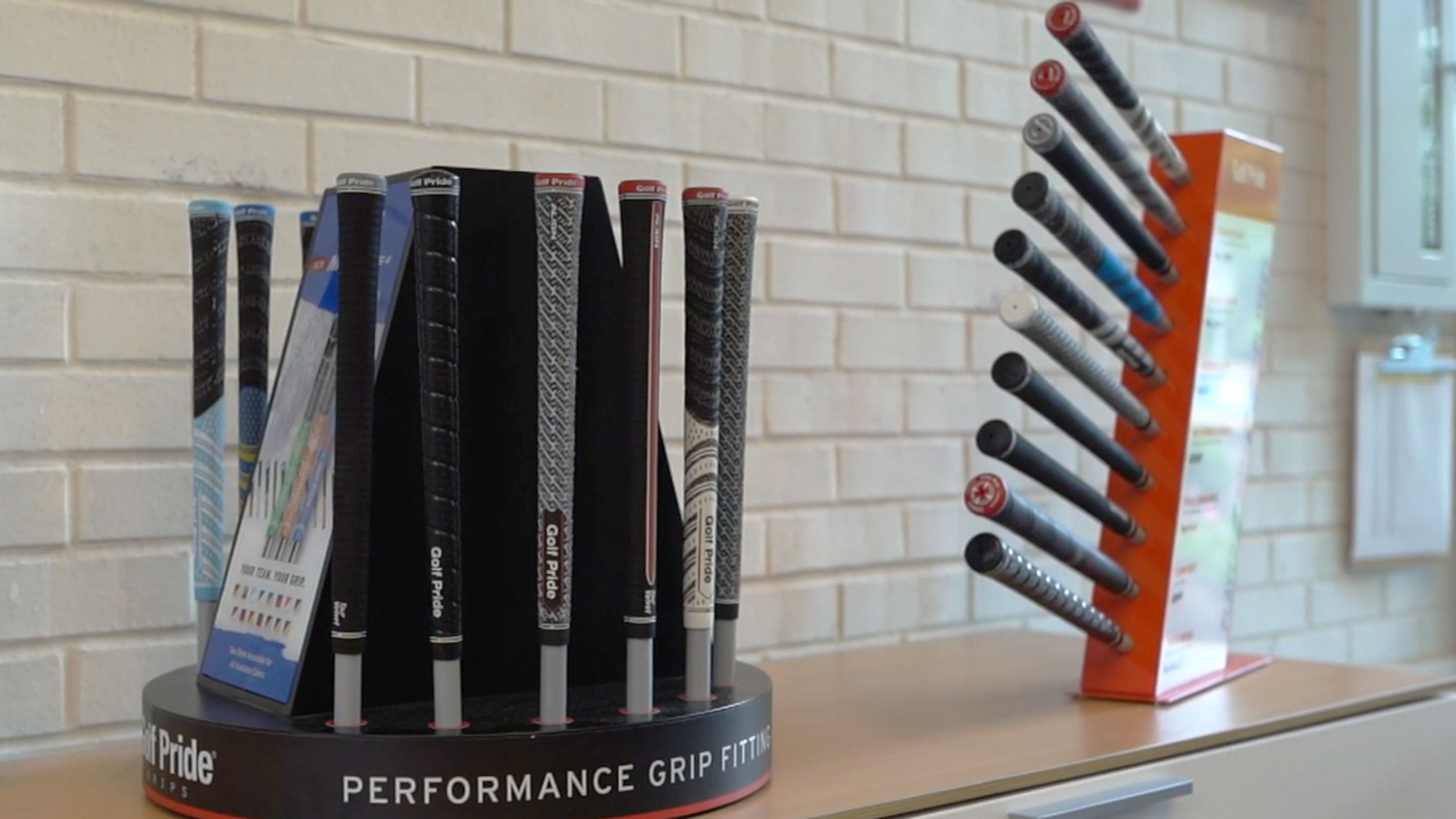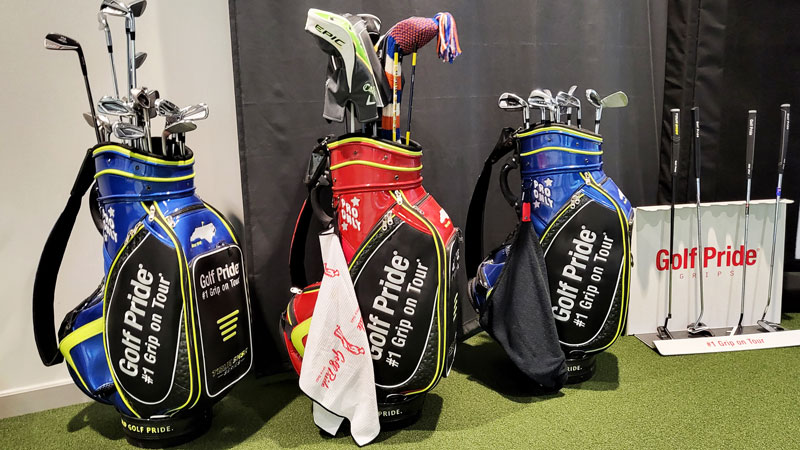How To Choose The Right Golf Grips For Your Game
If you're not thinking about your golf grips as part of your equipment, it's probably time to change your mindset


How To Choose The Right Golf Grips For Your Game
It’s an overused statement when it comes to golf grips yet still completely accurate: “Your golf grip is your sole connection to the club.” During a recent tour of Golf Pride’s new headquarters in Pinehurst, North Carolina, company president Jamie Ledford made that exact point. He also said that Golf Pride’s ultimate goal was to have golfers view their grips as equipment and not just the material that’s on the end of their clubs.
And that begs an interesting question: Why do golfers, who are so discerning when it comes to the clubs they choose, the balls they play, and the shoes they wear, seemingly care so little about their golf grips? When you really think about it, it doesn’t make a whole lot of sense. So below, we've outlined the things you should be considering when it comes to that part of your bag.
Choosing the right golf grips for your game comes down to three unique categories: size/fitting, feel/type, and performance. We take a deeper dive into each of those categories so that when you’re buying new clubs or contemplating new grips, you can make the right choice, which will help you on the course while also proving to be more cost effective in the long run.
Grip Size/Fitting

While giving a recent tour of Golf Pride's new fitting studio, Golf Pride president Jamie Ledford admires one of the actual MCC grips used by Jon Rahm in winning the 2021 U.S. Open.
At this point, the reality is that grip fitting isn’t an exact science, although Golf Pride is hoping to change that in the coming years through research and data collection. At present, however, fitting a player for proper sized grips predominantly comes down to hand size, but there are some patterns that can be found for golfers who are playing grips that are too big or too small.
Sara Bryant has been a Development Engineer with Golf Pride since April of 2020 and as part of her role she conducts grip testing and fitting at Golf Pride’s in-house fitting studio in Pinehurst. It’s a process she believes will provide value to golfers in time. But at this stage, the journey has just started, as she’s only beginning to collect the data that will identify tangible trends related to what can happen when playing the wrong sized grips.
“That’s, unfortunately, to come. I don’t have information right now,” said Bryant when asked about specific issues that she has seen for players in the wrong grip size. Much of the challenge for her in that regard revolves around capturing motion photography of how the hands work and interact with the grip during the swing, a daunting task given how biomechanically complex the hands are.
Subscribe to the Golf Monthly newsletter to stay up to date with all the latest tour news, equipment news, reviews, head-to-heads and buyer’s guides from our team of experienced experts.
Bryant did, however, add that golfers should rely on their on-course experiences to potentially identify that they’re in the wrong grip. “If you’re out on the course and maybe seeing this or feeling this, that means that maybe (you’re) in the wrong size or the wrong material or the wrong family of grip,” she said. “That’s really what I want to understand and learn so that I can provide players with the appropriate recommendation for their game.”
Bryant did say that she has seen some evidence that the wrong size grip can result in dispersion inconsistencies. “I did a preliminary study (of grip size) and looked at our undersize, standard, midsize, and jumbo grips and just from a quick evaluation we were seeing some trends. Undersize was a little more left, jumbo was a little more right,” she said. “It wasn’t statistically significant, so that’s something I want to (explore) to see what’s actually changing. Is that related to hand size? How is that actually changing? I know we have hand length, but is that the proper measurement?”

Golf Pride development engineer Sara Bryant talks about the research she's doing in an effort to advance grip fitting.
When it comes to golf grip sizes, there are generally four options available that players will have to choose from: standard, midsize, jumbo, and undersize, although depending on the company they could have different nomenclature. Interestingly enough, if you walk into a golf shop and buy clubs on the rack, it’s a near certainty that they will have standard-sized grips. Golf Pride, however, based on its extensive research, estimates that only 50 percent of golfers fit into standard grips as it relates to hand size.
The takeaway is that you need to do your research when buying golf clubs. There are online grip fitting resources available to help you make the right choice, and if you are going to be custom fit for golf clubs, make sure that your fitter conducts a popper hand measurement in addition to all of the other measurements that are being taken as part of the fitting process.
Also of note, keep in mind that there is no industry standard for what constitutes a “standard” grip or any other grip size, much as is the case when it comes to shaft flex. From brand to brand, and even within brands, grips that would be classed in the same category can vary in diameter and weight. Typically, a standard grip’s core is going to either be .580 inches or .600 inches, with the latter being most common today, while weights can vary by several grams.

Bryson DeChambeau uses oversized grips on all of his golf clubs
Be advised that choosing a new grip that differs in weight from what you were previously playing can affect the swing weight of your club(s). So if you’re shopping for new clubs and plan to make a grip change over what’s available to you on the shelf, you’re better off ordering the clubs you want with the grips you want to ensure that they’ll be accurate in terms of swing weight to perform as intended from a balance standpoint.
And finally, choosing a grip size can also relate to how you personally swing the golf club. Not every golfer who plays jumbo grips has huge hands. Rather, some golfers go that route to quiet their hands during the swing, which can prove helpful for golfers whose swings are driven by body rotation. If, however, you actively use your wrists, hands, and arms to create speed and power in your golf swing, which is also an effective way to play, smaller grips will likely help in that regard.
Grip Type/Feel

The MCC family of grips from Golf Pride represent the most popular hybrid grips on the market.
When you factor in the number of brands available and the different types of grips that each brand offers, there are tremendous options for players to choose from. Let’s start with the brands, where Golf Pride has emerged in recent decades as the clear industry leader. As evidence, Golf Pride can claim 80 percent of play on the PGA Tour and roughly 65 percent of the market share among recreational players.
Beyond Golf Pride, the two most recognizable and popular grip brands would be Lamkin, which was founded in 1925 and played most famously by Arnold Palmer throughout his career, and Winn, which has garnered a highly popular following since releasing its first golf grip in 1996. Other popular grip companies today include SuperStroke, Iomic, and Pure, all of which have smaller consumer bases but high-quality grips.
As for the types of grips that are available to golfers, there are three dominant categories to be aware of: Cords, Hybrids and Rubbers. Of those, Cord grips offer the firmest feel and the most rugged texture, which is popular with better players as it creates control and feedback during the swing. That said, the texture of a full Cord grip can be hard on the hands for players who aren’t used to it, and Cords are not the best option for those who play without a glove.

The new Golf Pride CPX is a rubber grip, and like most rubber grips will offer golfers a softer feel.
Some popular examples of Cord grips would be Golf Pride’s Tour Velvet Cord, played most notably by Tiger Woods, the Golf Pride Z-Grip Cord, which was used in winning fashion by ball-striker extraordinaire Will Zalatoris at the recent FedEx St. Jude Invitational, and the SuperStroke S-Tech Cord, which has been used by Jordan Spieth and Sergio Garcia, among others. Lamkin’s Crossline Cord and UTx are also among the game’s most popular Cord grips.
At the opposite end of the spectrum are most rubber grips, which offer softer feel in the hands, making them popular among higher-handicappers and newcomers to the game. Golf Pride’s new CPX and popular Tour Wrap are examples of softer rubber grips, and while Winn uses polymer instead of rubber, the majority of its grips would fall into the “soft” category as well. Lamkin’s “Sonar” range of grips also fit the bill, as do Pure Pro golf grips and the majority of the Iomic collection.
As for hybrid grips, these are options that typically use a combination of materials, including rubber and cord, but the biggest determining factor in their categorization will be that they offer a feel that falls in between the firmer Cords and softer, rubber grips.
The most well-known example of a hybrid grip is the Golf Pride Multicompound (MCC) family, which is used by Rory McIlroy and Jon Rahm. To give you an idea of how popular MCC grips are globally, it would be the No. 1 grip company in the world on its own. That said, others offer excellent hybrid grips as well, with Lamkin and SuperStroke having especially strong options in that category.
Grip Performance

Golf Pride conducts grip fittings on site at its Pinehurst performance studio to learn more about how golf grips can improve a player's on-course performance.
When it comes to grip performance, there’s no grip you can choose that will fix your golf swing or automatically make you a significantly better player. If there were, the USGA would deem it an “aid” and therefore non-conforming before the solvent on your re-grips dried. The key when it comes to choosing grips from a performance standpoint is to pick something that won’t hinder your on-course efforts while also helping you achieve what you’re trying to accomplish as a player.
From that standpoint, there’s obviously going to be some overlap between performance and the type of grip and size you choose, and getting those latter factors correct is crucial. But there are other things to consider as well, with comfort and confidence headlining the list. As an example, if you can't get your hands on the grip comfortably and repeatedly when you play, what chance do you have to be consistent?
“We’re really looking at performance and comfort with grips, because grips aren’t just (the) feel aspect,” Bryant advised. “That’s a big component but performance is as well. You always want, just like with a glove, whatever you feel that’s comfortable in your hands. That’s a good indicator, at least to start with. Comfort is still a huge component of golf grips. You want the player to feel comfortable, you want them to feel confident in what they’re playing.”
Additionally, you might want to consider how your grips can help you on the golf course based on your ability level, even if that means adjusting to a new feel. Golf Pride has identified some consistent trends in that regard, which resulted in part thanks to the overwhelming popularity of Tiger Woods over the course of the last couple of decades.

Tiger Woods has long played Golf Pride Tour Velvet Cord grips and that decision has had a major impact on better golfers around the globe.
“For a long time, it was Tiger,” Bryant said. “He used that Tour Velvet Cord, so that’s where a lot of the better players gravitated. What we found was, for them, it gives them better traction; they like that firmer feel. And a lot of times, those players have higher swing speeds, so they have higher theoretical grip forces. That’s something that we’re looking to understand better, but that means that these grips don’t wear (as quickly). Something with a softer feel, like a CPX or a Tour Wrap, is going to wear a little quicker for (better players).”
Another performance consideration would be workability and the type of grips that might best suit a shot-maker. For the recreational player who wants to work the ball around the golf course, a la Bubba Watson, Bryant said the decision is an easy one. “I would recommend a firmer grip because you want to feel the vibrations. You want to feel that movement,” she said. “You can feel those vibrations more (with a firmer grip); you can feel those hands working a little bit more.”
The other key performance consideration for your golf grips will be how they fare when moisture enters the equation, whether it’s rain or the sweat that golfers deal with during warm, humid weather. For some, that might not be a huge concern, but for avid tournament players, grips that function well in trying conditions can be invaluable.
“Anything with moisture, humidity, sweat, rain, it’s always those corded grips,” Bryant advised. “That just gives you that better traction. It’s a cotton material in the core, so it helps to dissipate some of the water. And then it’s easier to clean as well, and the rain can absorb from a towel a lot easier. And MCC is also a good one where you still get that really good traction with your glove hand.”
And lastly when it comes to performance, as previously discussed, there’s no rule that says you have to use the same grip type for all of your clubs. In fact, using different grips in your longest clubs as opposed to your shortest clubs can potentially offer some performance benefits, especially for more advanced players, so don’t be afraid to experiment with the grip configuration through your set to get the best results.

Chris joined Golf Monthly in February of 2022, becoming the organization’s first full-time staff writer in the United States. In his role at Golf Monthly, Chris reviews a broad spectrum of golf equipment, ranging from the latest in golf clubs to what’s new in the world of golf technology. His vast experience in the game allows him to look beyond the marketing hype to judge the merits of the latest equipment for golfers of all ability levels. As for the trend in golf equipment that Chris has been most impressed with in recent years, the Players Distance Iron category would earn that distinction, as golfers now have far better options for irons that provide the assistance that so many need in terms of distance and forgiveness without forcing them to sacrifice look and feel.
On a personal level, Chris played college golf and was a three-year letterwinner and two-year captain at Lynchburg College in Virginia and later spent two years as the assistant golf coach at the University of Virginia. The vast majority of his professional career, however, has been spent as a sports writer and editor. In the early phases of his career, he covered college football, college basketball, and golf for different newspapers and websites before turning his attention solely to golf in 2011. Over the course of the past decade, Chris managed the Instruction Blog for GolfChannel.com and more recently created equipment-related content for TGW.com and 2ndSwing.com.
An avid player, Chris currently maintains a handicap index of 2.4 and has a career-low round of 66, which he has shot on three occasions. He lives about 20 miles north of Atlanta in Roswell, Georgia, with his wife, Stacey, and is a member at Atlanta National Golf Club.
Chris is currently playing:
Driver: Callaway Epic Sub Zero, 10.5*
Fairway wood: TaylorMade M3, 17*
Hybrid: Callaway Apex UW, 19*
Irons: Mizuno JPX 921 Forged, 4-PW
Gap wedge: Cleveland RTX 4, 50*
Sand wedge: Titleist Vokey SM6, 56M
Lob wedge: Titleist Vokey SM8, 60L
Putter: SeeMore Nashville Z3C
Ball: TaylorMade TP5x